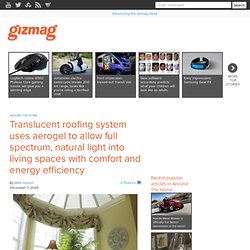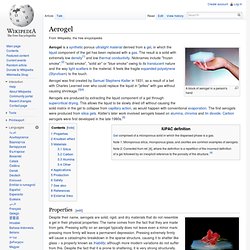

Translucent roofing system uses aerogel to allow full spectrum, natural light into living spaces with comfort and energy efficiency. December 8, 2005 Nanotechnology threatens some radical changes to the way we live – indeed, it threatens to change some of our fundamental belief systems.

Anyone with a rudimentary understanding of physics will tell you that putting a clear roof on our dwellings allowing full spectrum, natural light, will result in a disastrously inefficient energy monster. But nanotechnology can offer glass and polycarbonate remarkable new properties as this story illustrates. We’ve written about the world’s lightest substance before (here and here), but now some of aerogel’s other properties are beginning to find commercial application and by filling polycarbonate or glass with nanogel, the clear substances retain their light transmission qualities while delivering outstanding thermal insulation.
Consumers purchasing new homes are increasingly requesting floor plans that include more natural light, both to improve aesthetics and to reduce energy needed for interior lighting. VIG <p> <p> E_mail: huqinhu. New generation energy saving glass For use in historical buildings Most historical window frames cannot be adapted to support insulated glazing. In addition, the 15 mm or thicker insulated glazing panels conflict with the 4 mm original frames. The Government Building Agency “Rijksgebouwendienst” (RGD) of the Dutch ministry of Housing, Spatial Planning and the Environment (VROM) is responsible for government buildings. RGD often faces problems of meeting insulation standards in historical buildings.
For use in renovation projects for housing, the glass can be fitted in existing frames and replace single or low class energy saving glazing. For use in cold climates The “typical” window type depends on the area. Guardian Gearing Up to Bring Vacuum Glazing to Market. At the recent American Institute for Architects exhibition in San Francisco, Guardian Industries Corp. reported it is gearing up to introduce its vacuum insulating glass, or VIG, in late 2010.

It is working with a consortium of companies, including material and equipment suppliers and window manufacturers, including Jeld-Wen, to launch what Scott Thomsen, chief technology office, calls "leapfrog technology. " Prototype windows using VIG are now in the field in Europe, where Guardian expects to roll out the product initially, he reports, and the company anticipates it will have prototypes out in the field in North America sometime in the third quarter of this year.
The glassmaker plans to have "beta" products out on the market by the end of 2010, with and is looking to commercialize production in 2011. Guardian's vacuum glazing uses translucent ceramic pillars to separate the two panes of glass. VIG Vacuum-insulating glass: development and availability. Self-powered smart window.
Aerogel. A block of aerogel in a person's hand Aerogel was first created by Samuel Stephens Kistler in 1931, as a result of a bet with Charles Learned over who could replace the liquid in "jellies" with gas without causing shrinkage.[3][4] IUPAC definition Gel comprised of a microporous solid in which the dispersed phase is a gas.

Note 1: Microporous silica, microporous glass, and zeolites are common examples of aerogels. Note 2: Corrected from ref. [4], where the definition is a repetition of the incorrect definition of a gel followed by an inexplicit reference to the porosity of the structure. [6] Properties[edit] A flower is on a piece of aerogel which is suspended over a flame from a Bunsen burner. Aerogels are good thermal insulators because they almost nullify two of the three methods of heat transfer (convection, conduction, and radiation). Owing to its hygroscopic nature, aerogel feels dry and acts as a strong desiccant. Knudsen effect[edit] Materials[edit] Silica[edit] Carbon[edit] Alumina[edit] Smart Energy Glass – switchable glazing powered by the sun.